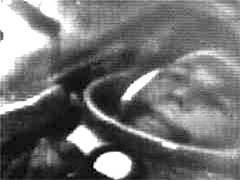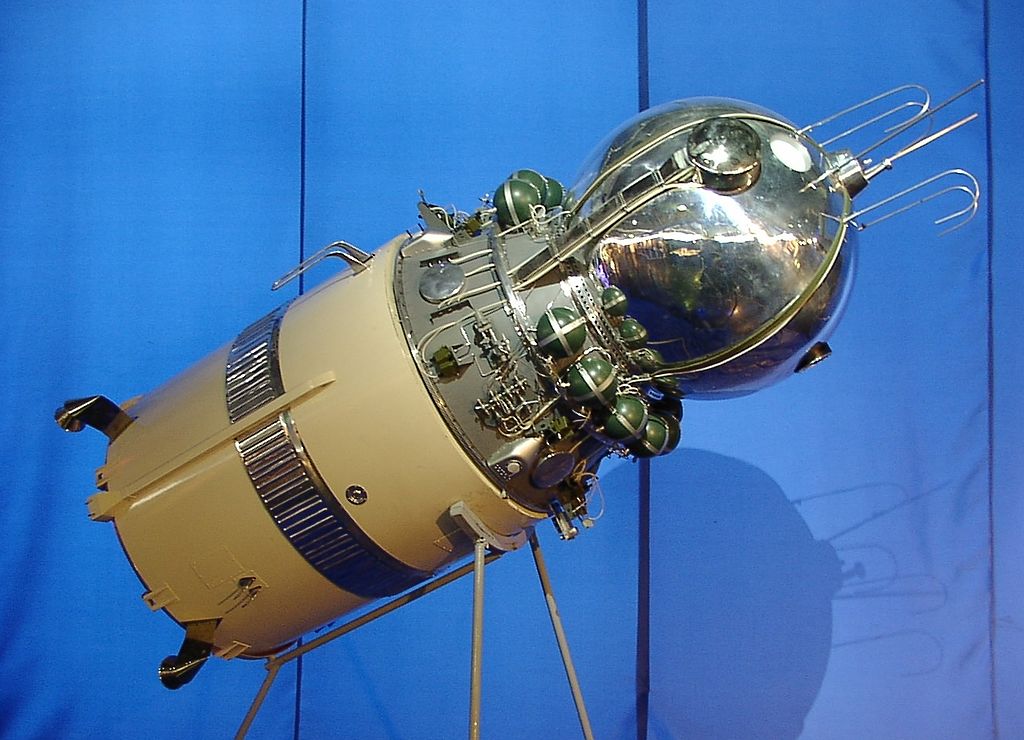While we've talked a lot about how there was a 'missile gap' between the US, we haven't talked about what started the panic. That missile was the R-7 Semyorka. And even when compared to other big intercontinental missiles, it was huge. It stood 112 feet tall, and the central core was 10 feet in diameter.
 |
| The launch of Sputnik |
Even though it was designed and built rather quickly, the R-7 had quite a few interesting design features. One of the main issues in early rocketry was stage separation. Once a booster is out of fuel, it's dead weight. Thus, spent stages needed to be ditched. The problem is that vertical stage separations were difficult and caused many launch failures in the Soviet program. What they decided to do was to separate the boosters horizontally. This is why there are four outer boosters around a central core on the R-7. The outer four would lift the rocket up to altitude, where they'd separate and leave the central core to carry on its nuclear journey. The separation also lead to one of the beautiful sights of rocketry: the "Korolev Cross."
 |
| The Korolev Cross of a modern Soyuz rocket, part of the R-7 family |
The R-7 family is still in use today, almost 60 years later. It ferried Sputnik to orbit, and shot Yuri Gagarin to orbit.
Yuri Gagarin
On April 12, 1961, a strange amount of activity was noticed at Baikanour Cosmodrome. A Vostok-K rocket (derivative of the R-7) stood on the launch pad, partially shrouded in condensation from the liquid oxygen stored inside. There was a tense atmosphere in mission control as final checks were carried out. Television screens showed live video of the cargo: an astronaut by the name of Yuri Gagarin. Sergei Korolev, the chief designer, started having chest pains and was very worried at the statistics. 24 test launches had been carried out. Only 12 had succeeded. Strangely enough, Gagarin was perfectly calm in his capsule.
At 6:07 Universal Time, the Vostok-K lifted off, Garagrin saying "Poyekhali!," "Let's go!" Ten minutes later the final engine shut off and the capsule separated from the rocket. The capsule drifted out of radio range, leaving Gagarin alone for a few minutes. About an hour later Gagarin turned the sun-seeking system on, orienting the capsule for re-entry. The retrorockets fired shortly after, nudging the spacecraft out of orbit. A command was sent up from mission control to separate the service module from the re-entry module (the one Gagarin was in). These failed to separate because of a stuck bundle of cables, leading to high g-forces over Egypt. The cables burned through, and the reentry module carried on through reentry.
Once the capsule slowed down enough and stopped burning, parachutes were deployed. Automatically, at 23,000 feet, explosive bolts blew the hatch off, and two seconds later Gagarin's ejection seat fired, shooting him out of the spacecraft. He then had a "pleasant" ten-minute parachute ride down to the ground. A farmer and his daughter were near where Gagarin landed, and started to back away in fear (It's not every day a figure in a bright orange suit and white helmet parachutes from the sky. Gagarin told them "don't be afraid, I am a Soviet citizen like you, who has descended from space and I must find a telephone to call Moscow!"
_misil.svg/320px-R-7_(7A)_misil.svg.png)



No comments:
Post a Comment